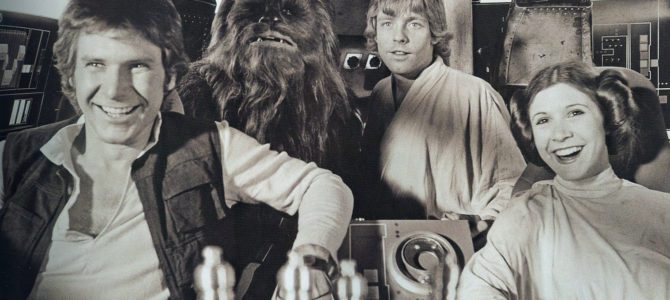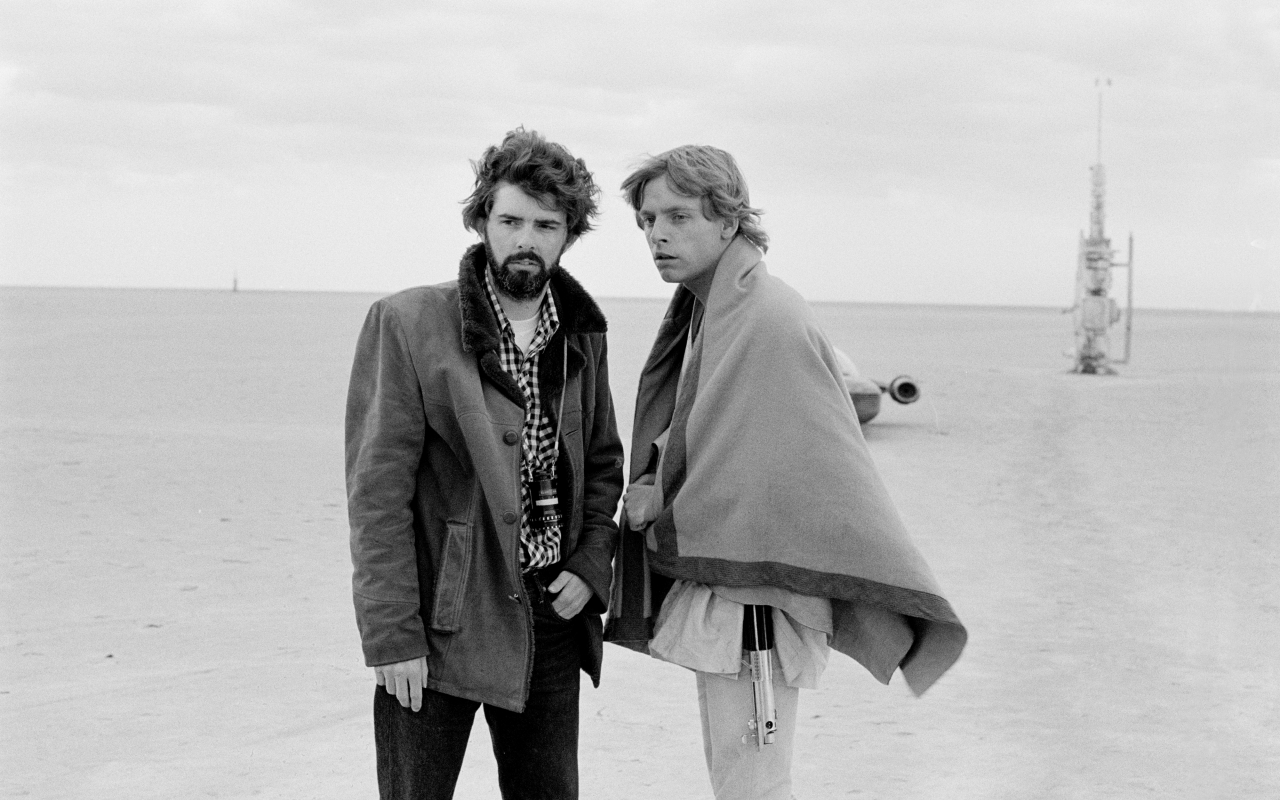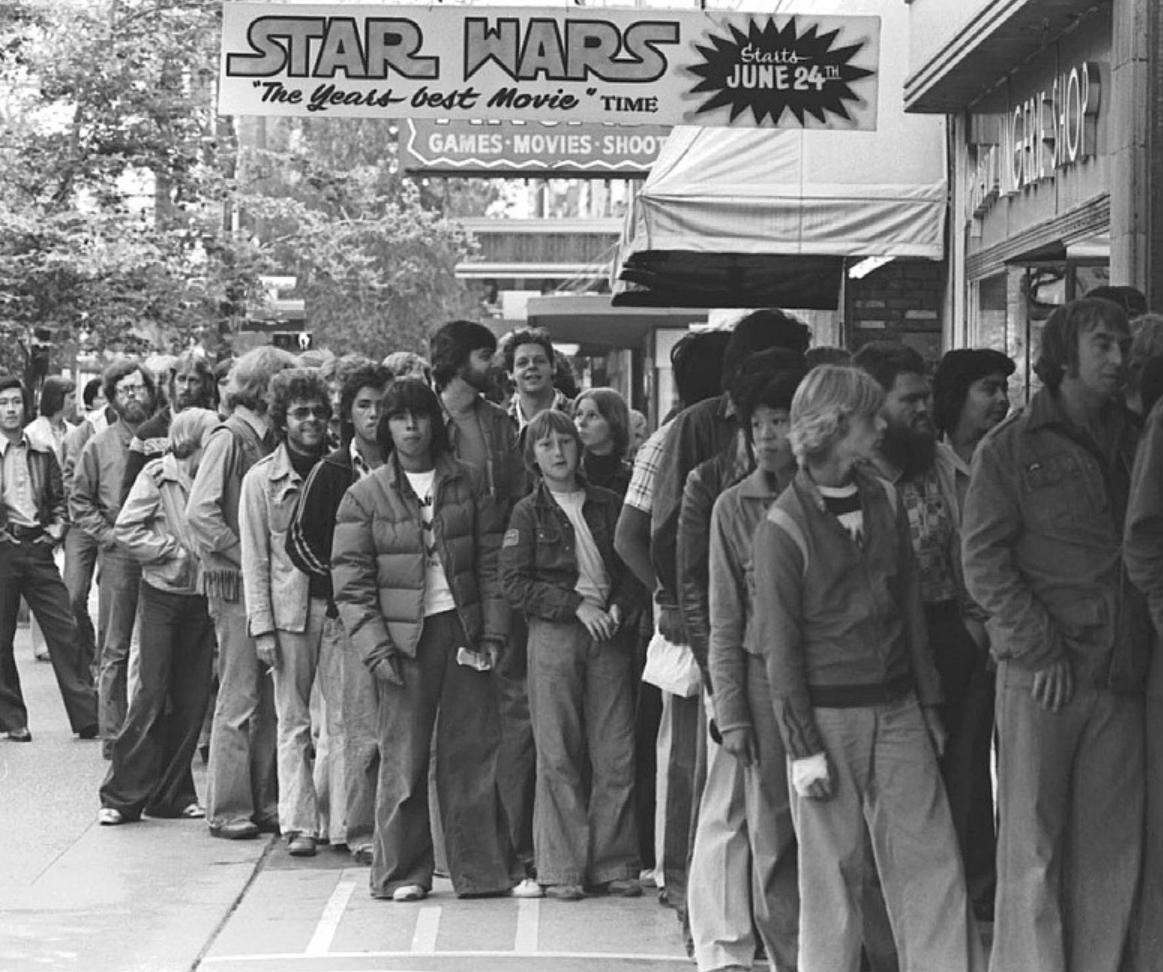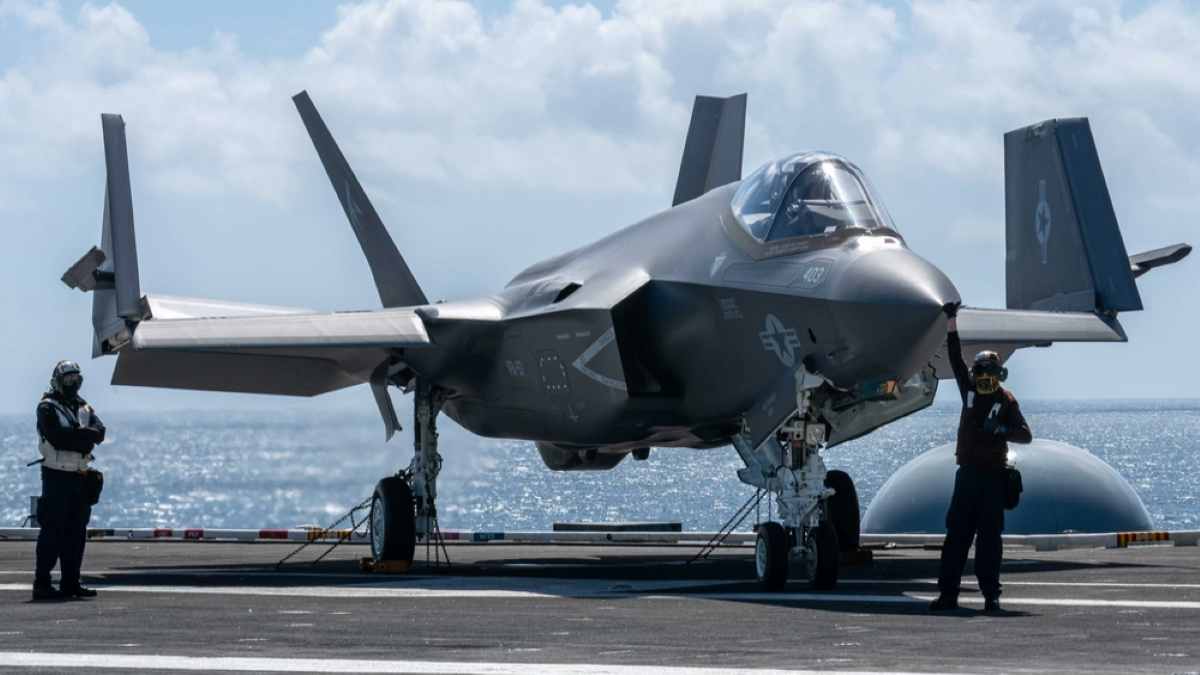
On May 25, 1977, movies changed forever. That was the day 40 years ago when the first “Star Wars” movie debuted. Thousands of fans waited outside theaters in long lines to see what would become the greatest space opera of all time. The film kicked off a series that would change the meaning of the term blockbuster, revolutionize special effects, and bring modern movie merchandising to the world.
When George Lucas began writing what would become Star Wars, he was inspired by Buck Rogers, Akira Kurosawa samurai films, and the car culture of California that Lucas grew up in during the 1950s and ‘60s. Hollywood didn’t know what to do with it originally. Lucas has said it was difficult to get studios to take him seriously. He found a champion at 20th Century Fox, and that’s where Star Wars was born.
The Birth of Modern Movie Merchandising
One of the biggest changes “Star Wars” ushered in was mass market merchandising, something Hollywood relies upon now for their bottom line but wasn’t as big a deal in 1977. In fact, as Lucas negotiated a deal with Fox for the sequels in the wake of the original movie’s success, he was able to nab the money from merchandise sales, which made him a fortune over the ensuing decades.
Today when movie-goers sit down for a blockbuster they expect to be wowed by big-budget special effects, amazing music and sound design, and inundated by cross-promotions for clothes, toys, food, and many other things they hadn’t known they needed. That massive marketing blitz wasn’t standard before “Star Wars.” Target wasn’t full of plush toys, baby clothes, bed sheets, Legos, action figures, and video games tied to every major movie. Now, however, kids and adults alike line up for “Force Friday” before every “Star Wars” movie to spend ungodly amounts of money on the latest merchandise.

The toy industry is now built upon major film franchises. Look down the toy aisles at your local Target or Walmart, and you’ll see Star Wars, Batman, Ninja Turtles, “Frozen,” Harry Potter, and many more movies represented in the action figures, dolls, Legos, puzzles, collectibles, and video games. Lego has risen to be one of the world’s most recognizable toy brands because of their incredibly popular “Star Wars” construction sets. My office shelves are stocked with a Lego X-Wing, Millennium Falcon, Ghost, and many, many more sets and figures.
My son sleeps on “Star Wars” sheets, my daughter has a string of BB-8 night lights in her room, and half of my T-shirts bear a “Star Wars” character of one sort or the other. All of that is owed to the birth of modern movie merchandising that began 40 years ago.
Star Wars Revolutionized Special Effects
All of today’s blockbusters also owe their special effects to “Star Wars.” Lucas and his team at Industrial Light and Magic (ILM) changed the way directors were able to tell stories through special effects. This was before the age of computers, so nearly everything had to be done practically. That meant making lots of small, incredibly detailed models of spaceships and using matte paintings and camera tricks to give the illusion that these were life-size fighters battling it out in space, or a space station the size of a moon.
ILM had to create all the robots in the film, filling some with little people to operate the emotive metal machines. They had to make each of the costumes, weapons, and creatures, whether you saw them for much of the film, like Chewbacca, or just in passing, like many of the customers at the Mos Eisley cantina. Big set-pieces weren’t created in a cubicle by a computer geek, but constructed on location. They built a universe that was lived-in, dirty, worn, and completely immersive. Aliens looked otherworldly but with real facial expressions, crazy appendages, and complex, developed languages, adding to the experience. “Star Wars” was more than you could imagine within your own head. It was simply amazing!

“Star Wars” also featured cutting-edge sounds. Whether it was the hum of the lightsabers, the pew-pew of the blasters, the roar of the engines, or the incredible music, “Star Wars” sounded different. Ben Burtt, who designed many of the film’s iconic sounds and is a pioneer in his field, went to great lengths to find what worked, mixing bits and pieces from the real world to create the sounds of a galaxy far, far away. The team that would become Skywalker Sound blazed an audio technology trail that studios and movie theaters still follow today.
What really made “Star Wars” such a joy to listen to, though, was the music. The rich, rousing score composed and conducted by John Williams is legendary. It is widely considered one of the best film scores of all time. Lucas said recently that Williams is the “secret sauce” of the franchise, and he’s right. Whether it’s the foreboding march that indicates the coming of Darth Vader, the sweet theme of Princess Leia, or the inspiring sounds of the Force, Williams pulls “Star Wars” together.
Star Wars Is Full of Memorable Characters
“Star Wars” also introduced perhaps the most memorable villain in all of cinema, Darth Vader. Encased in a black suit, covered with a menacing helmet, and followed by a flowing cape, Darth Vader is the definition of evil and intimidation. Voiced by James Earl Jones, and accompanied by the now-famous labored breathing, Vader is the villain you love to hate. His mere silhouette still strikes fear into people’s hearts. Using the mystical “Force,” Vader was able to move objects, choke people with a thought, and wield a lightsaber with deadly efficiency.
Vader wasn’t the only memorable character to come from the movie. Now we think of all the major actors in “Star Wars” as household names, big box office stars known the world over, but at the time Mark Hamill, Harrison Ford, and Carrie Fisher were all young and not well-known. Ford famously auditioned for the role after he came to Lucas’s attention while building a door in Francis Ford Coppola’s office. He was a carpenter and pilot long before he was a movie star.

The most well-known actor in the “Star Wars” cast was Sir Alec Guinness, who played Obi-Wan Kenobi. He openly said he disliked the series and role. Peter Cushing, another esteemed British actor, was also well-known, but neither of these men were the focus of the movie. Ford was the biggest breakout star, going on to do the “Indiana Jones” series, “Blade Runner,” several Tom Clancy movies, and other major motion pictures, winning acclaim and making him the second highest-grossing actor of all time, with movies that total nearly $4.9 billion in sales.
The most ground-breaking hero of the original Star Wars movie may have been Princess Leia, played by Carrie Fisher. The princess in the white dress with big hair buns was a legitimate female action hero. She stood up to the darkest of villains, took guff from no one, and blasted her way out of trouble. A fierce leader of the Rebellion, she was a big-screen hero girls the world over could emulate. It’s a focus of much discussion and effort in studios big and small now, but in 1977 we saw it on the silver screen thanks to Lucas.
With the sudden loss of Fisher last year, that mantle of “Star Wars” heroine will officially pass to Daisy Ridley’s Rey, who was introduced in “The Force Awakens,” Jyn Erso from “Rogue One,” and lesser-known female characters like Ahoska Tano, Hera Syndulla, and Sabine Wren. They all owe their success to the Princess.
A Movie For 12-Year-Olds Became So Much More
At Star Wars Celebration this year, Lucas said he wanted to make a sci-fi series that was different, one with mystical and philosophical elements. That’s where the “Force” comes in. Used by Jedi, and their evil opposite the Sith, the Force is an energy that surrounds all living things, binding the galaxy together. Those with special powers study the Force, learning to manipulate it. It made onscreen magic more believable. I, and many other kids, thought that if we concentrated hard enough we too could make a lightsaber fly from the table into our hands. I’m still working on that. I’ll let you know when it finally happens.
Although there are now generations of Star Wars fans, many old enough to have kids or even grandkids who love the movies, Lucas didn’t make his tale in a galaxy far, far away for the average adult. In his appearance at Star Wars Celebration, Lucas said the dirty little secret is that it’s a movie for kids: “I’m not supposed to say this, but this is a film for 12-year-olds.”
Lucas said he wanted to show kids on the cusp of entering the real world what was important: “Friendship, honesty, trust. Living on the light side, avoiding the dark side.” What he intended to be a simple story about good versus evil became so much more in the summer of 1977. It became a franchise, a movement, a culture filled with fans of every age, sex, and race. Big or small, old or young, rich or poor, millions upon millions of people in the world are “Star Wars” fans.
Star Wars Redefined Blockbusters
This movie redefined the term “blockbuster.” What came to be known as “Star Wars: A New Hope,” is the second highest-grossing film of all time at the U.S. box office when adjusted for inflation. It made nearly $461 million, which becomes just shy of $1.5 billion when adjusted for inflation, putting it behind only the 1939 classic “Gone with the Wind.”
This was before digital downloads, DVDs, and even the widespread popularity of VCRs, so when you liked a movie you saw it multiple times in the theater. Films stayed in theaters for months and months so fans could return to the experience. People who saw the first movie in 1977 will tell you they saw it four, five, six times, maybe even more.

I didn’t see a Star Wars movie in the theaters until “Return of the Jedi,” but I then watched all of them on VHS so much that the tapes were worn. By the time “A New Hope” was re-released in 1997 to celebrate its 20th anniversary, I knew the intricacies of every scene, bar of music, and line of dialogue. My mom, in a bid for mom of the year, stood in line for tickets for me and my friends while we were at school.

Now I’m old enough that I take my own kids to see Star Wars movies in the theater. We pile on the couch to watch one of the movies or TV shows in the franchise at least once a month. We play with the toys, wear the clothes, and my daughter can’t sleep at night without her stuffed BB-8.
Since Disney bought it a few years ago, the Star Wars brand is in the midst of a massive renaissance that shows no signs of slowing down. In 2015, with “The Force Awakens,” it burst back onto the big screen. With one cartoon series on TV and another on the way, video games on phones and consoles, and merchandise on every aisle of big box stores, the Force is still strong with the franchise.
No one could have guessed that an obscure sci-fi film in 1977 from a young director, with few big stars, and an out-of-this-galaxy plot would one day become the ultimate force in Hollywood, but thanks to Lucas and millions of fans the world over, “Star Wars” changed the film industry forever. Now, 40 years after its debut, “Star Wars” is as much a part of American culture as freedom, football, and apple pie, and 40 years from now I’m sure my grandkids will be still be saying, “May the Force be with you!”









